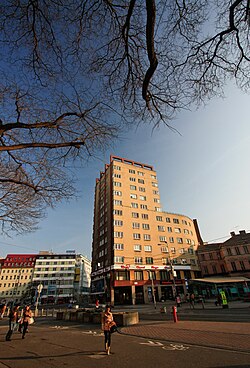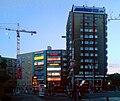Manderlák Building
| Manderlák Building | |
|---|---|
Obchodný a obytný dom Manderla (Slovak) | |
 | |
 | |
| General information | |
| Status | Completed |
| Location | Bratislava, Old Town, Slovakia |
| Address | Námestie SNP 23, Bratislava |
| Coordinates | 48°08′40″N 17°06′45″E / 48.14458°N 17.11246°E |
| Construction started | 1934 |
| Completed | 1935[1] |
| Height | |
| Roof | 45 m (148 ft)[1] |
| Technical details | |
| Structural system | Concrete |
| Floor count | 11[1] |
| Design and construction | |
| Architect(s) | Christian Ludwig, Emerich Spitzer & Augustín Danielis[2] |
The Manderlák Building (Slovak: Obchodný a obytný dom Manderla) is a high-rise residential building in Bratislava, Slovakia.[3] Standing at 45 metres (147 ft) tall with 11 floors and built between 1934 and 1935, the construction was the first-ever high-rise building in Slovakia and the tallest in the country between 1935 and 1967.[1][4]
History
[edit]Architecture
[edit]The building was designed and built by German architects Christian Ludwig, Emerich Spitzer and Augustín Danielis for the Slovak businessman and butcher Rudolf Manderla, who was inspired by the design of slaughterhouses in Chicago. It is the first habitable high-rise building in Slovakia and was named after Manderl himself.[5]
When they started to shape up the concept of the building, the three architects decided they should somwhow remain faithful to the traditional architecture styles, therefore their biggest challenge was to decide at what extent they should use the principles of modern architecture. In the early 1930s, they began proposing several solutions, some of them coming from the traditional Slovak architectural styles, and some of them portraiting modernist architecture of the 1930s. In the first designs from June 1933, the high-rise building was conceived as a compact mass, cantilevered above the pavement and without supporting columns. Ceramic cladding was used on the facade with horizontal windows. The attic was punctuated by V-shaped cutouts.[6][1]
In another design solution, the cantilever extension was replaced by the support of six columns and the attic with a prominent line of the horizontal railing of the roof terrace. The brick structure and windows grouped in strips enhanced the expressive character of the high-rise building.[1]
In the end, the construction firm of Alexander Feigler and the local branch of the Viennese construction company Pittel+Brausewetter realized the design, which is characterized by restrained purist moderation. They built a tower that had eleven floors, which was above the average height for its time, defiantly standing on four solid pillars.[1]
The ground floor of the house is characterized by a modern archway and a curved passage with entrances to smaller establishments and a butcher shop, which is an integral part of the building today. The architects achieved the airiness and lightness of the ground floor by designing large window openings. On the first floor were offices and the historic Grand Cafe, which was the center of Bratislava's bohemia. There are 64 two and three-room apartments on the upper floors. The equipment of the building was at a very modern technical level for its time.[7]
See also
[edit]Gallery
[edit]-
The tower seen from street level
-
The tower seen from Kamenné námestie
-
Detail of the building with perspective
-
Street level view
References
[edit]- ^ a b c d e f g "Manderla apartment and commercial block". register-architektury.sk (in Slovak). Register of modern architecture oA HÚ SAV. Retrieved September 20, 2024.
- ^ "Manderlák". bratiska.sk. Bratiska. Retrieved September 20, 2024.
- ^ "Manderla in Bratislava - Slovakia's first highrise apartment building". modernism-in-architecture.org. Modernism in Architecture (MIA). Retrieved September 20, 2024.
- ^ Sarközi, Andrej (June 26, 2023). "The symbol of Bratislava has come: they want to declare Manderlák a national cultural monument". asb.sk (in Slovak). Retrieved September 20, 2024.
- ^ "Manderlák was built by businessman Manderl - he was born 140 years ago". teraz.sk (in Slovak). TASR. July 10, 2024. Retrieved September 20, 2024.
- ^ Jakubjaková, Katarína (September 30, 2023). "How does it feel to live in Manderlák, Bratislava's first high-rise building?". The Slovak Spectator. Retrieved September 20, 2024.
- ^ "PHOTO and VIDEO: Manderlák is probably known by every resident of Bratislava - however, the house still hides many secrets!". bratislavskenoviny.sk (in Slovak). Bratislavské noviny. October 1, 2018. Retrieved September 20, 2024.
Further reading
[edit]- Dulla, M.: Slovak architecture from Jurkovič to today . Bratislava: Perfect, 2007. p. 43.
- Dulla, M. and collective: Masters of architecture . Bratislava: Perfekt, 2005. p. 60-61.
- Dulla, M. – Moravčíková, H.: Architecture of Slovakia in the 20th century . Bratislava: Slovart, 2002. p. 84, 172, 379–380.
- Foltyn, L.: Slovak architecture and the Czech avant-garde 1918 – 1939 . Bratislava: SAS, 1993. p. 153, 194.
- Kusý, M.: Architecture in Slovakia 1918 – 1945 . Bratislava: Pallas, 1971.
- Moravčíková, H.: Traditions and innovation in the architectural work of Christian Ludwig. Architecture & Urbanism 31, 1997, No. 4, p. 197-198.
- Šlachta, Š. – Dorotjaková, I.: Guide to the architecture of Bratislava 1918 – 1950 . Bratislava: Meritum, 1996. p. 6.
- Buildings and structures in Bratislava
- Buildings and structures completed in 1935
- Residential buildings completed in 1935
- 1935 establishments in Slovakia
- 1935 establishments in Czechoslovakia
- Skyscrapers in Slovakia
- 20th-century architecture in Slovakia
- Modernist architecture in Slovakia
- Buildings and structures in Czechoslovakia




